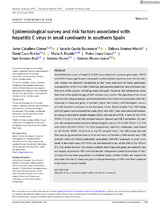Mostrar el registro sencillo del ítem
Epidemiological survey and risk factors associated with hepatitis E virus in small ruminants in southern Spain
| dc.contributor.author | Caballero-Gómez, Javier | |
| dc.contributor.author | García-Bocanegra, Ignacio | |
| dc.contributor.author | Jiménez-Martín, Débora | |
| dc.contributor.author | Cano Terriza, David | |
| dc.contributor.author | Risalde, M.A. | |
| dc.contributor.author | López-López, Pedro | |
| dc.contributor.author | Jiménez-Ruiz, Saúl | |
| dc.contributor.author | Rivero-Juárez, Antonio | |
| dc.contributor.author | Rivero, Antonio | |
| dc.date.accessioned | 2022-05-17T08:12:48Z | |
| dc.date.available | 2022-05-17T08:12:48Z | |
| dc.date.issued | 2022 | |
| dc.identifier.uri | http://hdl.handle.net/10396/22942 | |
| dc.description.abstract | Autochthonous cases of hepatitis E (HE) associated with zoonotic genotypes HEV-3 and HEV-4 have significantly increased in industrialized countries over the last decade. Suidae are generally recognized as the main reservoirs of these genotypes. Susceptibility to HE virus (HEV) infection and zoonotic potential have also been confirmed in other species, including sheep and goat. However, the information about their role in the epidemiology of HEV remains very scarce. The objective of this study was to assess the prevalence, spatial distribution and risk factors associated with HEV exposure in sheep and goats in southern Spain, the country with the highest census of small domestic ruminants in the European Union. Blood samples from 240 sheep and 240 goats were collected between 2015 and 2017. Sera were analysed in parallel using a commercial double-antigen ELISA and real-time PCR. A total of 38 (7.9%; 95%CI: 5.5–10.3) out of 480 sampled animals showed anti-HEV antibodies. By species, the seroprevalences found in sheep and goats were 2.1% (5/240; 95%CI: 0.3–3.9) and 13.8% (33/240; 95%CI: 9.4–18.1) respectively. Anti-HEV antibodies were found on 19 (59.4%; 95%CI: 42.4–76.4) of the 32 sampled farms. The GEE model showed that species (goat) and number of small ruminants in the farm (≤348 animals and ≥538 animals) were risk factors potentially associated with HEV exposure in small ruminants in the study area. HEV RNA was not detected in any of the 480 (0.0%; 95%CI: 0.0–0.8) tested animals. Our results confirm that sheep and goats are naturally, but not equally exposed to HEV and indicate the widespread spatial distribution of HEV among small ruminant populations in southern Spain. Further studies are required to elucidate the role of sheep and goat in the epidemiology of HEV and their potential implications for public health. | es_ES |
| dc.format.mimetype | application/pdf | es_ES |
| dc.language.iso | eng | es_ES |
| dc.publisher | Wiley | es_ES |
| dc.rights | https://creativecommons.org/licenses/by-nc-nd/4.0/ | es_ES |
| dc.source | Zoonoses Public Health 69:387-393 (2022) | es_ES |
| dc.title | Epidemiological survey and risk factors associated with hepatitis E virus in small ruminants in southern Spain | es_ES |
| dc.type | info:eu-repo/semantics/article | es_ES |
| dc.relation.publisherversion | https://doi.org/10.1111/zph.12935 | es_ES |
| dc.relation.projectID | Gobierno de España. RD12/0017/0012 | es_ES |
| dc.relation.projectID | Gobierno de España. FPU17/01319 | es_ES |
| dc.relation.projectID | Gobierno de España. CP18/00111 | es_ES |
| dc.relation.projectID | Unión Europea. EJ20-AGR-149/ AGR-013 | es_ES |
| dc.relation.projectID | Unión Europea. 2018/12504 | es_ES |
| dc.rights.accessRights | info:eu-repo/semantics/openAccess | es_ES |

